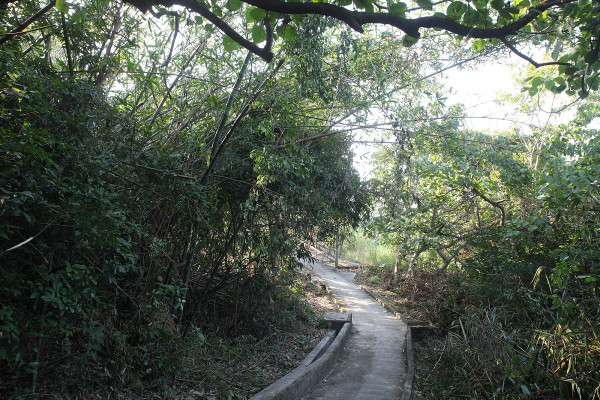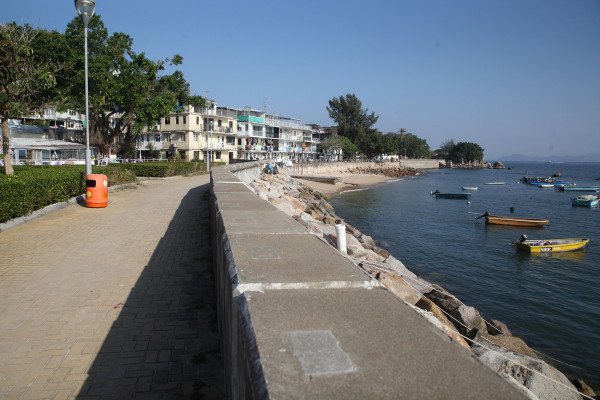Listen 來聽
The Songs of Birds and Bamboo 鳥風竹浪
Listen 來聽 / Meanderings - Feature Story 咫尺 - 專題故事 / Feature: Tuning Silences — Listening to Peng Chau 怎個靜字了得 — 耳聽坪洲
Text 文:Yip Kai-chun/ 葉啟俊 English Translation 英譯: Yoyo Chan/ 陳蕾
Nov 2017 - Jan 2018
Hong Kong/ 香港
Zoom H6 Handy Recorder
Bamboo, Bird, insect, onomatopoeia, Peng Chau, wave, 坪洲, 擬聲, 浪, 竹, 蟲, 鳥
The Songs of Birds and Bamboo
On a tiny island like Peng Chau, the boundary between nature and human habitation is almost indistinguishable.
Surrounded by the sea and sparsely populated with low buildings, the rather spacious Peng Chau has much stronger winds than in the city. No recording equipment can block out the sound of these winds. Poet Louise Law is particularly fond of the howling of these winds. “Every typhoon stages a recreation of The Turin Horse (a film by director Béla Tarr in 2011) and blow the whole house away.” As Government and Public Administration Lecturer Franz Mang recalled, when the T10 Typhoon ‘Hato’ blasted through Hong Kong last year, his home in Tung Wan flooded and he was left with no choice but to brave the hurricane to clean up his balcony: “Like a scene in Dragon Ball, the place appeared to have been bombed and completely wiped out by an energy ball. The low ‘hor’ sound, like that in the scene where Planet Namek was about to be destroyed, struck a lasting impression on me.” When I looked out of my own window that day, Typhoon Hato had turned the world into a crystal snow globe and the squeaky shriek of the wind was so piercing that it seemed it could almost break the glass.
Probably because they both live by the sea, Louise and Franz consider the sound of waves to represent Peng Chau. However Georgia’s focus lies in the bamboo found everywhere on the island: “The bamboo close-by Nam Shan’s mountain top, creak and rustle as the breeze blows. All I have to do is to put a contact microphone on top of them and it already sounds beautiful.” The bamboo shafts sway slowly in unison, sounding like an old, rusted machine.
Birds of all kinds make themselves heard everywhere on the island. In the island’s centre their vibrant calls grace every house, and they are even more evident along the country trails. Bird sounds are also the first thing you hear when you wake up in the morning: these sounds make Sze, “feel alive, feel the world outside even when you are still in bed in the morning.”
The natural sounds of trees, waves, dogs, and fire (when the farmers burn the land) on Peng Chau not only remind Nelson, a native Hawaiian, of his childhood, they give him a “stronger feeling of home” than even present-day Hawaii, “which looks more like Central nowadays” (quoting Sze). These sounds of nature—not necessarily exclusive to Peng Chau—are country songs away from the bustle of city life.
鳥風竹浪
小島少不了自然,而且和民居相與,界線不明。
坪洲空曠,四面環海樓又矮,風力比市區大得多。在錄音時,才為意坪洲風大,錄音機避不到風聲。詩人羅樂敏(Louise)卻喜歡這大風聲,打颱風時「好似<都靈老馬>(The Turin Horse,貝拉塔爾2011年導演)咁,成間屋係咁俾風吹」。政治及公共行政講師孟繁麟(Franz)憶述,去年十號風球天鴿吹襲,他位於東灣的居所水浸入屋,不得不出露台清理,「好似龍珠咁,有個能量球炸咗個地方,周圍變晒樣,南美星就嚟毀滅嗰陣,『呵~~~』(低音)咁嘅聲……個聲好震憾,好深印象。」我記得的天鴿,令窗外的世界變成個玻璃雪球,發出尖銳得好像可以衝破玻璃的風聲。
大概因為住在海邊,Louise和Franz均說,浪聲是他們心目中的坪洲聲音。而Georgia則留意到四處的竹:「喺南山山頂附近嘅竹,隨風發出吱吱嘎嘎嘅聲,我擺個接觸式咪喺上面,好好聽。」竹在竹羣中緩慢移動的聲音,好像一座老化的機器。
但要數在島上每一處都聽到的聲音,一定是雀。莫說坪洲的郊遊徑,就是在島中心的民居,都可以聽到不同的雀聲。這也是早上起牀,其中一個最先聽到的聲音。阿史甚至認為,那聲音令她「感到生存,朝早起身喺牀感受到出面嘅世界」。
Nelson在夏威夷出身、成長,坪洲自然的聲音諸如樹、浪、狗、火(農民燒土),令他想起小時候的夏威夷,甚至比現在變得「好似中環」(阿史語)的夏威夷更有「家嘅感覺」。這些「自然」的聲音,未必為坪洲獨有,而是遠離繁囂的鄉鎮之聲。
:: Recording 錄音 ::
Typhoon Hato/ 颱風天鴿
0’15”
Yip Kai-chun/ 葉啟俊
Evening/ 傍晚, 11/01/2018
Tung Wan/ 東灣
Zoom H6 Handy Recorder/ Recorder in stationary position/ 錄音機靜置
onomatopoeia/ 擬聲
Autumn insects/ 秋蟲
2’22”
Yip Kai-chun/ 葉啟俊
Evening/ 傍晚, 06/11/2017
Wai Tsai Tsuen/ 圍仔村
Zoom H6 Handy Recorder/ Recorder in stationary position/ 錄音機靜置
insect/ 蟲
Waves, bamboos and birds/ 浪竹鳥
3’18”
Yip Kai-chun/ 葉啟俊
Afternoon/ 下午, 20/01/2018
Around Tung Wan/ 東灣附近
Zoom H6 Handy Recorder/ Handheld/ 手持錄音
wave, bamboo, bird/ 浪、竹、鳥
Bamboo/ 竹
4’11”
Yip Kai-chun/ 葉啟俊
Afternoon/ 下午, 20/01/2018
Peak of Nam Wan/ 南灣山頂
Zoom H6 Handy Recorder/ Handheld/ 手持錄音
bamboo/ 竹
Birds on a tree at the Leather Factory/ 牛皮廠樹的雀
4’56”
Yip Kai-chun/ 葉啟俊
Morning/ 上午, 20/01/2018
Leather Factory/ 牛皮廠
Zoom H6 Handy Recorder/ Handheld/ 手持錄音
bird/ 雀
bamboo drum/ 竹葉鼓
0’52”
Yip Kai-chun/ 葉啟俊
Afternoon/ 下午, 17/01/2018
Nam Wan Peak/ 南灣山頂
Zoom H6 Handy Recorder/ Handheld/ 手持錄音
:: Tuning Silences — Listening to Peng Chau 怎個靜字了得 — 耳聽坪洲 ::
> Prologue 引言
1. Low Volume Ear Cleansing 清耳仔的底聲
2. Noises in Serenity 靜中帶嘈
3. The Songs of Birds and Bamboo 鳥風竹浪
4. Festivals and Ritual Ceremonies 慶典祭祀
5. Ferries Coming & Going 船來船往
< Conclusion 結語

由島上任何一處行一會 就不太聽得見人聲
You will no longer hear much human voice after walking for a while on the island

但島上任何一角 都聽到鳥風竹浪
Yet the songs of birds and bamboo could be heard anywhere on the island
bamboo drum/ 竹葉鼓
0’52”
Yip Kai-chun/ 葉啟俊
Afternoon/ 下午, 17/01/2018
Nam Wan Peak/ 南灣山頂